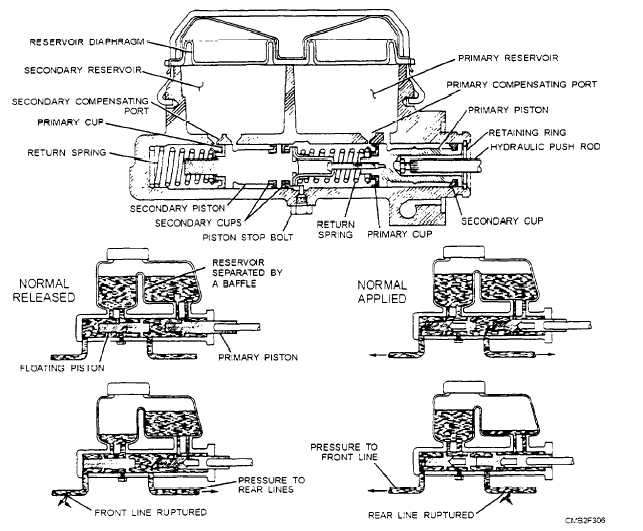Home > Construction Training Manuals > Construction Mechanic Basic Volume 2 > Figure 7-5.Dual Master Cylinder.
A rubber boot prevents dust, dirt, and moisture from entering the back of the master cylinder. The boot fits over the master cylinder housing and the brake pedal pushrod.
The reservoir carries a sufficient reserve of fluid to allow for expansion and contraction of brake fluid and brake lining wear. The reservoir is filled at the top and is well sealed by a removable filler cap containing a vent. Integral reservoirs are made of the same material as the cylinder. whereas detachable reservoirs are made of plastic.
The intake port or vent allows fluid to enter the rear of the cylinder, as the piston moves forward. Fluid flows out of the reservoir, through the intake port, and into the area behind the piston and cup.
The compensating port releases extra pressure when the piston returns to the released position. Fluid can flow back into the reservoir through the compensating port. The action of both ports keeps the system full of fluid.
The residual pressure check valve maintains residual fluid pressure of approximately 10 psi. This pressure prevents fluid from seeping past the cups in the wheel cylinders and also prevents air from entering the hydraulic passages when the brakes are released.
Older vehicles used single piston, single reservoir master cylinders that were dangerous. If a fluid leak developed (cracked brake hose, seal damage, or line rupture). a sudden loss of braking ability occurred. Modern vehicles use dual master cylinders. These master cylinders provide an additional safety feature in that should one portion of the brake system fail. the other system will allow the vehicle to maintain some braking ability.
The dual master cylinder (fig. 7-5). also called a tandem master cylinder, has two separate hydraulic

Figure 7-5. - Dual master cylinder.
Continue Reading